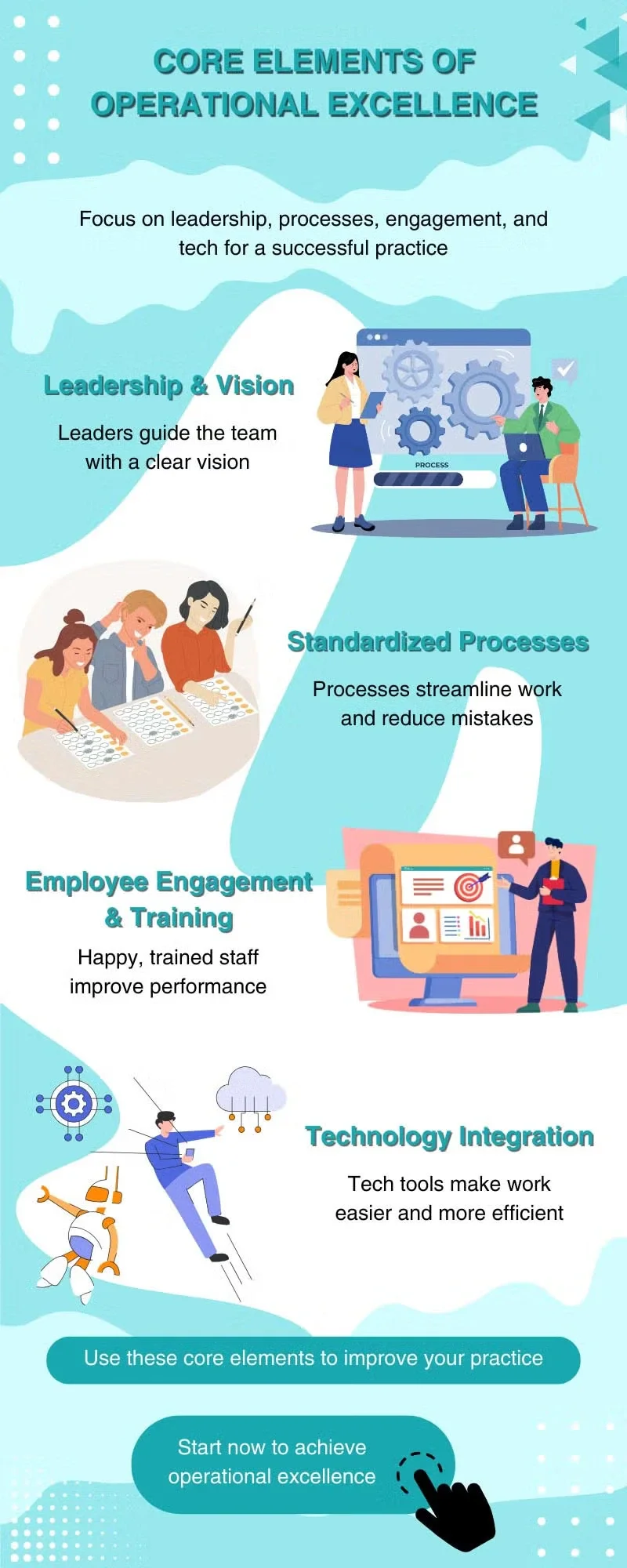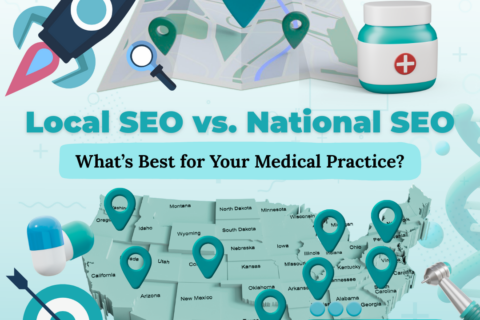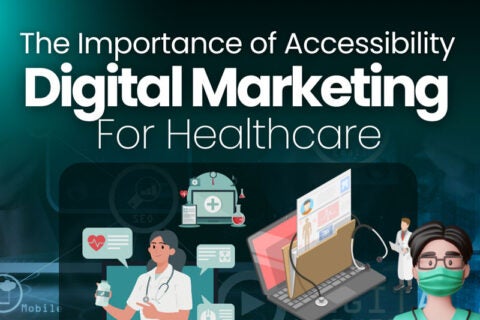Core Elements of Operational Excellence
Operational Excellence in Private Practice
Operational excellence is the cornerstone of a successful private practice. But what does operational excellence actually mean in this context? At its core, it refers to the ability to run a practice with maximum efficiency, effectiveness, and continuous improvement. This involves optimizing processes, reducing waste, enhancing patient experiences, and creating a culture of constant evaluation and adaptation. Achieving operational excellence isn’t just about smooth day-to-day operations—it’s about setting up a foundation that allows your practice to thrive in the face of industry challenges and patient demands.
For small to mid-sized private practices, operational excellence is not just a luxury—it’s a necessity. With larger healthcare networks dominating much of the market, independent practices must find ways to remain competitive while still providing personalized, high-quality care. By improving operational performance, practices can not only enhance the patient experience but also streamline internal workflows, improve financial health, and better meet the needs of their community. The competitive edge that operational excellence provides can help practices differentiate themselves in a crowded market and build stronger, long-term relationships with patients.
This blog aims to provide actionable insights for small to mid-sized practices looking to streamline their operations and improve overall performance. From optimizing patient flow and financial processes to leveraging technology and developing a culture of continuous improvement, the strategies outlined here will help your practice run more smoothly, reduce costs, and create a more positive experience for both patients and staff. With a focus on sustainable growth, we’ll guide you through the steps to achieve operational excellence and position your practice for long-term success.
The Core Elements of Operational Excellence
Achieving operational excellence requires focusing on several core elements that influence every aspect of a private practice’s daily operations. These elements are the foundation for creating a highly efficient, patient-centered environment. By focusing on leadership, standardized processes, employee engagement, and technology integration, practices can build a culture of excellence that ensures sustainable growth and enhanced patient care.
Leadership and Vision
Leadership plays a critical role in driving operational excellence. The practice’s leadership team sets the tone for the entire organization, influencing everything from patient interactions to employee morale. Strong leaders create a clear, shared vision for the practice’s future, ensuring all team members understand and align with the mission and values. This alignment helps drive consistency and purpose in the way the practice operates, which is key to maintaining high standards of care and patient satisfaction.
Effective leaders focus on setting realistic, measurable goals, ensuring that everyone from physicians to administrative staff knows their role in achieving these objectives. By fostering a culture of continuous improvement and accountability, leadership helps the practice evolve and adapt in response to the dynamic healthcare environment.
Standardized Processes
One of the foundational aspects of operational excellence is the development of standardized processes across all aspects of the practice. Standard Operating Procedures (SOPs) help eliminate confusion, reduce errors, and streamline workflows. Key areas such as patient intake, appointment scheduling, billing, and follow-up procedures benefit greatly from clear, documented guidelines.
For example, a standardized intake process ensures that patient information is collected consistently and accurately, saving time and reducing administrative errors. Similarly, a standardized billing process can ensure that insurance claims are filed promptly and accurately, improving cash flow and reducing costly billing mistakes. By creating clear SOPs for each process, a practice can ensure efficiency, improve patient satisfaction, and reduce stress on staff members.
Employee Engagement and Training
The success of any practice is largely dependent on the people who work there. Engaged and well-trained employees are crucial to operational excellence. When staff members are motivated and feel valued, their performance improves, and they contribute to a positive work environment.
Ongoing training is essential, as it keeps employees up-to-date with the latest healthcare practices, technologies, and compliance regulations. Cross-training staff in different roles not only ensures greater operational flexibility but also strengthens the overall team dynamic, as each member gains a deeper understanding of the practice’s broader goals.
Engagement also involves giving staff opportunities for professional development and providing feedback. By fostering an environment where team members feel supported in their growth, you can ensure that the practice is staffed with highly skilled professionals who are aligned with the practice’s mission.
Technology Integration
Incorporating technology into practice operations is an essential aspect of achieving operational excellence. Modern digital tools like Electronic Health Records (EHRs), practice management software, and telemedicine platforms help streamline workflows, improve data management, and reduce administrative burdens.
EHR systems, for instance, help ensure that patient records are accurate, accessible, and secure, improving communication between team members and reducing the chances of error. Practice management software can automate appointment scheduling, billing, and patient communications, further improving efficiency and reducing administrative workload. Telemedicine, in particular, allows practices to expand their services while minimizing the operational overhead associated with in-person visits. Integrating these technologies into your practice can significantly improve patient care and help your practice stay competitive in a rapidly changing healthcare landscape.

Enhancing Patient Flow and Experience
Efficient patient flow and an exceptional patient experience are key components of operational excellence. A well-run practice not only ensures that patients receive timely, high-quality care but also provides an environment where patients feel valued and cared for. By improving patient scheduling, communication, in-office experiences, and personalizing care, practices can increase patient satisfaction and loyalty.
Efficient Patient Scheduling and Intake
Efficient patient scheduling is one of the first steps in creating a smooth patient experience. By optimizing appointment scheduling, practices can reduce wait times, minimize no-shows, and ensure that patients receive timely care. Implementing online scheduling options, setting appointment reminders, and offering flexible scheduling for busy patients can make the process more convenient for everyone.
Automating reminders via text, email, or phone calls helps keep patients on track and reduces no-show rates, which can lead to more efficient use of the practice’s time and resources. Additionally, streamlining the intake process by utilizing digital forms or pre-visit questionnaires can ensure that patient information is collected quickly and accurately, allowing staff to focus on more critical tasks.
Patient Communication
Clear, timely communication with patients is key to building trust and ensuring a positive experience. Communication should happen at multiple touchpoints throughout the patient journey, from appointment reminders and pre-visit instructions to post-visit follow-ups and billing inquiries.
Best practices for patient communication include using secure, HIPAA-compliant messaging tools for sending appointment reminders and follow-up care instructions. Automating these communications ensures that patients are kept informed without adding extra work for office staff. Additionally, using personalized communication, whether through emails or phone calls, helps patients feel valued and cared for.
Streamlining the In-Office Experience
The in-office experience is a critical part of the patient journey. Minimizing wait times, improving office layout, and enhancing the overall patient experience can create a positive impression that encourages patient loyalty and generates referrals.
One way to reduce wait times is to improve scheduling accuracy. Ensure that patients are seen on time, and when delays do happen, provide clear updates. Improving office layout and creating a welcoming, calming environment can also enhance the patient experience. Comfortable waiting areas, clear signage, and easy access to services are simple but effective ways to improve the overall atmosphere of the practice.
Personalized Care and Experience
Finally, providing personalized care is one of the most effective ways to build patient loyalty and generate referrals. Patients are more likely to return to a practice and recommend it to others when they feel that the practice genuinely understands and caters to their individual needs.
Personalized care can be as simple as remembering patient preferences, following up on previous concerns, or offering individualized treatment options. Creating a patient-centric culture ensures that every patient feels valued, leading to stronger relationships and higher patient retention. By making patients feel seen and heard, you create a foundation for long-term success.
Improving the Financial Health of the Practice
A practice’s financial health is critical to its sustainability and growth. By improving the financial operations and ensuring a steady cash flow, a private practice can reduce financial strain, reinvest in growth, and ensure long-term viability. There are several areas where practices can focus on improving financial performance, from streamlining billing and collections processes to managing costs effectively.
Revenue Cycle Management
Effective revenue cycle management (RCM) is a key driver of a practice’s financial health. The RCM process includes everything from scheduling appointments to finalizing patient payments, so it’s essential to ensure that every step is optimized.
Steps to improve RCM include:
- Coding Accuracy: Ensure that all medical codes are accurate, specific, and up to date. Incorrect or outdated coding can lead to claim denials, delayed payments, and audits, all of which hurt cash flow. Staff should be trained in the latest coding practices, and periodic audits should be conducted to ensure compliance.
- Insurance Follow-Ups: Unpaid insurance claims or delayed reimbursements can have a serious impact on cash flow. Implement a system for tracking and following up on insurance claims. Use practice management software to monitor claims and ensure timely follow-up on any unpaid claims. Having a dedicated team or individual responsible for insurance follow-ups can dramatically improve payment timelines.
- Patient Payment Systems: Simplifying the payment process for patients can help improve cash flow. Offering multiple payment options (e.g., credit/debit cards, mobile payments, payment plans) can make it easier for patients to pay their bills. Implementing transparent billing practices, such as providing clear estimates upfront, can also reduce disputes and delays in payment.
Cost Management
Reducing operational costs is essential for improving a practice’s financial health. By identifying areas of inefficiency or waste, a practice can lower overhead costs and increase profitability.
Areas to focus on include:
- Inventory Management: Properly managing medical supplies and office resources can reduce unnecessary spending. Conduct regular inventory audits and identify opportunities to consolidate purchases or negotiate better rates with suppliers.
- Outsourcing Non-Essential Functions: Consider outsourcing non-medical or non-essential functions such as payroll, billing, or IT services. By outsourcing these tasks, you can save on staffing costs and ensure that these areas are managed by experts, allowing your team to focus on patient care.
- Energy Efficiency: Implementing energy-efficient practices such as LED lighting, efficient HVAC systems, and smart thermostats can lower utility bills. Additionally, regularly maintaining office equipment to ensure it’s running efficiently can help extend its lifespan and reduce repair costs.
Financial Reporting and Analysis
Regular financial reviews and accurate reporting are critical for understanding the practice’s financial health and making informed decisions. Financial analysis allows practice owners and managers to spot trends, identify problems, and make strategic decisions. Key elements of financial reporting include:
- Regular Financial Reviews: Schedule monthly or quarterly reviews of the practice’s financials, including profit and loss statements, balance sheets, and cash flow reports. This will help you monitor revenue and expenses, assess performance, and identify opportunities for improvement.
- Key Financial Metrics: Understand the financial metrics that matter most to your practice, such as:
- Revenue per visit or patient
- Average collection period
- Days in accounts receivable
- Operating expenses as a percentage of revenue
- Profit margins
- Data-Driven Decisions: Use financial data to drive decisions. If certain services or treatments are more profitable, you may want to focus on promoting them. Conversely, if costs are rising in a particular area (such as supplies or labor), investigate potential solutions to reduce these costs.
Maximizing Insurance Contracts and Reimbursement Rates
Negotiating favorable insurance contracts and increasing reimbursement rates are essential for maximizing the practice’s revenue potential. Strategies for improving insurance and reimbursement include:
- Negotiating Insurance Contracts: Regularly review and renegotiate contracts with insurance companies to ensure that reimbursement rates are competitive. Use your practice’s performance data to show insurers that you are a high-quality provider, which may help secure better rates.
- Improving Documentation: Proper documentation and coding are crucial for maximizing reimbursement. Ensure that patient visits and procedures are thoroughly documented to justify the services provided. This reduces the likelihood of claim denials and increases the chance of higher reimbursements.
- Appealing Denied Claims: Denied claims should be carefully reviewed and appealed when necessary. Many practices fail to follow up on denied claims, but with the right system in place, you can recover significant amounts of revenue from insurance disputes.
Building a Culture of Continuous Improvement
To achieve sustained operational excellence, private practices must foster a culture of continuous improvement. This involves regularly evaluating processes, gathering feedback, using data to make informed decisions, and setting clear goals to drive progress.
The Role of Feedback Loops
Creating feedback loops is an essential component of continuous improvement. Feedback from both patients and staff can highlight areas for improvement and guide decision-making.
- Patient Feedback: Regularly gather feedback from patients about their experiences, whether through surveys, online reviews, or in-person discussions. Understanding their pain points can help you fine-tune the patient journey and identify areas to improve patient satisfaction.
- Staff Feedback: Employees are often the best source of insight regarding operational inefficiencies. Encourage open communication and create avenues for staff to provide constructive feedback. Conduct regular staff meetings or one-on-one check-ins to discuss pain points and potential solutions.
- Implementing Change: Once feedback is collected, develop action plans to implement improvements. Establish clear processes for addressing patient concerns, implementing operational changes, and following up to ensure that changes are effective.
Data-Driven Decision Making
Using data and analytics is one of the most powerful tools available for continuous improvement. By regularly analyzing key performance metrics, you can make informed decisions that drive operational success.
- Identifying Bottlenecks: Analytics can help identify bottlenecks or inefficiencies in your practice’s workflow. For example, if patient intake times are longer than expected, analytics can point to the specific stage where delays are occurring, allowing you to address the issue directly.
- Optimizing Operations: Data can also reveal trends in patient volume, appointment types, and other areas of operations that can guide strategic decisions. By using performance metrics to inform your decisions, you can improve productivity, reduce waste, and enhance patient satisfaction.
Setting and Tracking KPIs (Key Performance Indicators)
Key Performance Indicators (KPIs) are critical metrics that help practices track progress toward operational goals. By regularly measuring KPIs, practices can ensure they’re staying on track and adjusting as needed to improve performance.
Common KPIs for private practices include:
- Patient Satisfaction: Measures the quality of care and the overall patient experience.
- Revenue per Visit: Indicates the profitability of each patient encounter.
- Appointment No-Show Rate: Tracks how often patients miss scheduled appointments.
- Collection Rate: Measures the percentage of billed charges that are successfully collected.
By setting clear goals for each KPI and regularly tracking them, practices can improve areas of weakness, celebrate successes, and drive continuous improvement in all areas of the business.
Benchmarking Against Industry Standards
Benchmarking involves comparing your practice’s performance against industry standards or similar practices. This process helps identify areas where your practice may be falling short or excelling and provides insights into best practices.
- External Benchmarks: Look at industry reports or consult with medical associations to find benchmarks for common metrics such as patient volume, revenue per visit, and staff turnover rates. By comparing your practice to industry standards, you can set realistic targets for growth and efficiency.
- Internal Benchmarks: Compare performance across different areas of your practice, such as different locations or departments, to identify best practices or areas of underperformance. Internal benchmarking also helps identify top-performing staff or teams who can serve as models for improvement across the organization.
Achieving Operational Excellence for Sustainable Growth
Operational excellence is the foundation of a thriving private practice. By focusing on key areas such as leadership, standardized processes, employee engagement, and financial management, practices can significantly improve their efficiency, enhance patient experiences, and ultimately achieve long-term success. The journey towards operational excellence requires continuous improvement, leveraging technology, and ensuring that every aspect of your practice aligns with the goal of delivering exceptional care while maintaining a financially healthy business.
For small to mid-sized private practices, adopting these strategies isn’t just a way to stay competitive; it’s an investment in the future. The healthcare market is evolving rapidly, and practices that prioritize operational excellence will be better positioned to navigate challenges, meet patient expectations, and achieve sustainable growth.
As you take steps to streamline your operations, remember that operational excellence is not a one-time project but a mindset that needs to be integrated into your practice’s culture. Whether it’s optimizing your revenue cycle, improving patient flow, or fostering a culture of continuous improvement, the benefits will be felt across every area of your practice.
If you’re ready to elevate your practice’s operations and ensure long-term success, start today by identifying key areas for improvement, setting clear goals, and committing to continuous learning and growth. Embrace operational excellence as a strategic initiative, and watch your practice flourish in an increasingly competitive healthcare landscape.


